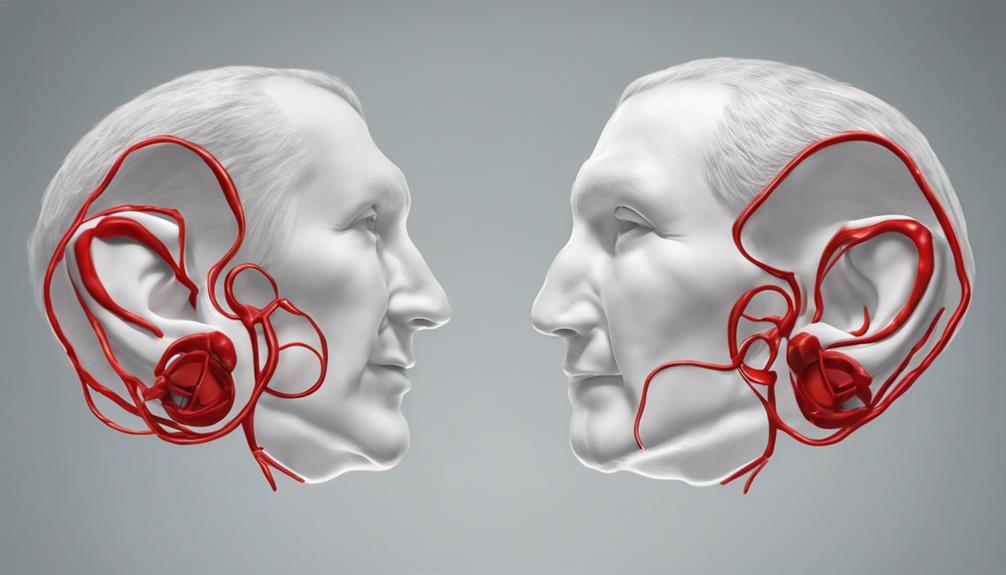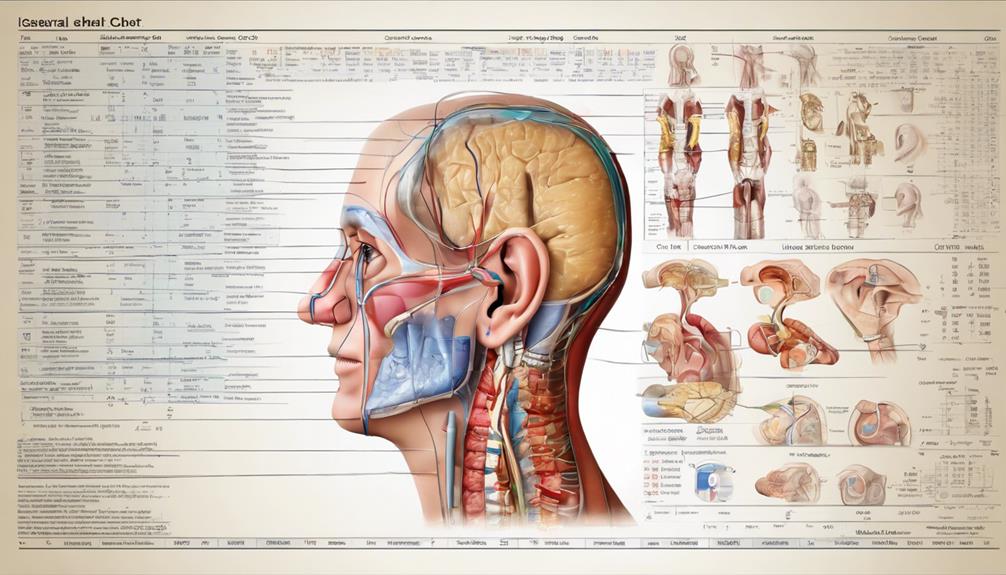In the realm of medical diagnosis, it is often said that “The devil is in the details.”
So, what is the ICD code for Bilateral Hearing Loss that healthcare professionals rely on for accurate classification and billing purposes?
Understanding this specific code is crucial for ensuring proper documentation and reimbursement in the medical field.
Let's explore the significance of this code, the intricacies involved in its application, and the impact it has on patient care and administrative processes.
Key Takeaways
- ICD-10-CM code H91.93 is used for bilateral hearing loss.
- Accurate coding aids in insurance claims and treatment reimbursement.
- Detailed documentation supports proper diagnosis and interventions.
- Distinguishing between conductive and sensorineural types is crucial for coding.
Overview of ICD Code for Bilateral Hearing Loss
When diagnosing bilateral hearing loss, healthcare providers commonly use the ICD-10-CM code H91.93 to indicate unspecified impairment in both ears. This specific code, H91.93, is crucial for accurately documenting cases of bilateral hearing loss where the exact nature or cause of the impairment isn't specified.
Bilateral hearing loss, as denoted by the term 'bilateral' in the ICD-10-CM code, refers to a condition affecting both ears simultaneously. The use of ICD-10-CM code H91.93 signifies a general classification for cases where hearing loss is present in both ears without further details provided.
While this code doesn't offer specifics on the severity or type of hearing loss, it plays a fundamental role in ensuring proper documentation and coding of instances of unspecified hearing impairment affecting both ears. Healthcare professionals rely on this code to accurately capture and classify cases of bilateral hearing loss, facilitating effective communication and management of patient care.
Importance of Proper Coding

Proper coding for bilateral hearing loss is crucial for accurate documentation and effective management of patient care. Ensuring the correct ICD codes are used is essential for various reasons, including processing insurance claims efficiently and obtaining reimbursement for treatments. Accurate coding also aids healthcare providers in tracking and managing bilateral hearing loss cases, leading to better patient outcomes. Furthermore, utilizing the appropriate ICD code enhances data collection for research purposes and supports public health initiatives related to hearing loss. Proper coding not only benefits individual patient care but also plays a significant role in monitoring trends, evaluating outcomes, and implementing interventions on a broader scale.
- Accurate ICD coding provides a clear picture of the patient's condition.
- Proper coding boosts the quality of care provided to individuals with bilateral hearing loss.
- Effective coding ensures seamless communication among healthcare professionals.
- Accurate coding helps in creating comprehensive treatment plans for patients.
- Proper ICD codes facilitate better coordination of care for individuals with hearing loss.
Diagnosis and Documentation Guidelines

To ensure precise coding and billing for bilateral hearing loss, it's imperative to accurately document the specific side affected and the nature of the hearing loss using the ICD-10-CM code H91.93. When diagnosing bilateral hearing loss, it's crucial to specify whether it affects the left, right, or both ears. This detailed documentation is essential for coding purposes and ensures that the appropriate ICD code is assigned.
Additionally, describing the nature and severity of the hearing loss in the medical records supports the medical necessity for treatment interventions and helps in determining the appropriate course of action. Adhering to the chapter-specific coding guidelines for bilateral hearing loss is vital to maintain correct coding practices and ensure accurate reimbursement.
Including additional diagnostic information in the documentation further strengthens the diagnosis of bilateral hearing loss and provides a comprehensive overview of the patient's condition. Proper diagnosis and documentation are fundamental in delivering quality healthcare services and optimizing patient outcomes.
Reimbursement and Billing Considerations

Navigating the landscape of reimbursement and billing for bilateral hearing loss hinges on a thorough understanding of the specific ICD-10 codes associated with this condition. Properly coding for bilateral hearing loss is essential for accurate reimbursement. Here are some key considerations to keep in mind:
- Precision in Coding: Choosing the correct ICD-10-CM code for bilateral hearing loss is crucial for successful reimbursement.
- Documentation Accuracy: Accurate documentation supporting the diagnosis of bilateral hearing loss is vital for billing purposes.
- Reimbursement Variability: Reimbursement rates can vary based on the specific ICD-10 code used for billing bilateral hearing loss services.
- Compliance is Key: Adhering to coding guidelines and regulations is necessary for compliant billing and reimbursement.
- Linking Diagnosis to Code: Ensure that the diagnosis of bilateral hearing loss is appropriately linked to the corresponding ICD-10 code in healthcare claims for smooth reimbursement processes.
Coding Challenges and Solutions

When addressing coding challenges and solutions for bilateral hearing loss, it is essential to understand the intricacies of ICD-10 codes and documentation requirements. Proper documentation and adherence to specific coding guidelines are crucial for accurate billing and reimbursement. One common coding challenge is distinguishing between conductive and sensorineural bilateral hearing loss, as the ICD-10-CM code varies based on this classification. Below is a table outlining some key aspects related to coding bilateral hearing loss:
| Category | Description | Example ICD-10-CM Code |
|---|---|---|
| Conductive Hearing Loss | Results from problems in the outer or middle ear affecting sound conduction | H91.2 |
| Sensorineural Hearing Loss | Caused by damage to the inner ear or auditory nerve impairing sound perception | H90.3 |
| Documentation Requirements | Detailed information on the type, severity, and etiology of hearing loss | H91.93 |
| Coding Guidelines | Follow specific instructions for accurate coding and proper reimbursement | H91.93 |
Frequently Asked Questions
What Is the ICD-10 Code for Bilateral Hearing Loss in 2023?
When we talk about ICD-10 codes for medical conditions, accuracy is crucial.
In 2023, the specific code for bilateral hearing loss is H91.93. This code is used to indicate unspecified hearing loss affecting both ears.
It's important to document this correctly for medical coding and billing purposes. Remember, using the correct ICD-10 code ensures proper healthcare reimbursement.
What Is Unspecified Hearing Loss Bilateral?
Unspecified bilateral hearing loss refers to a condition affecting both ears without specifying the exact cause or nature of the loss. Understanding this term is crucial for accurate documentation and billing.
It's represented by ICD-10-CM code H91.93. This code excludes conditions like abnormal auditory perception or noise-induced hearing loss.
Following chapter-specific guidelines ensures proper coding and classification for unspecified bilateral hearing loss.
What Is the ICD-10 Code for Bilateral Mixed Hearing Loss?
When coding for bilateral mixed hearing loss in ICD-10, accuracy is crucial. The code H90.6 denotes a combination of conductive and sensorineural hearing loss in both ears. It's vital for healthcare providers to document and treat this condition correctly.
Understanding and applying the code H90.6 ensures effective billing, tracking, and management of cases. Proper coding practices benefit both patients and healthcare professionals.
What Is the ICD-10 Code for Other Specified Hearing Loss of Both Ears?
We can shed light on the current inquiry regarding the ICD-10 code for other specified hearing loss of both ears.
The code H91.93 is applied when the hearing impairment isn't distinctly conductive or sensorineural, denoting a generalized, unspecified type of hearing loss affecting both ears.
This code excludes conditions like abnormal auditory perception or noise-induced hearing loss.
Accurate documentation and coding of bilateral hearing loss are crucial for appropriate medical billing and tracking.
Conclusion
In conclusion, proper coding of bilateral hearing loss with ICD-10-CM code H91.93 is crucial for accurate medical classification and billing processes.
Despite potential challenges in coding, following documentation guidelines and utilizing the correct code ensures proper reimbursement.
Don't let coding complexities deter you from accurately representing this condition in medical records – understanding the importance of correct coding is key to effective healthcare management.











